Detailed Analysis of the Value Chain for Marks and Spencer
VerifiedAdded on 2023/01/16
|11
|2568
|49
Report
AI Summary
This report provides a detailed analysis of the value chain model, using Marks and Spencer (M&S) as a case study. It begins with an introduction to the value chain model, explaining its importance in strategic planning and analyzing a company's internal environment. The main body of the report breaks down the value chain into primary and support activities, illustrating how M&S applies these concepts within its operations. It examines inbound and outbound logistics, operations, marketing, sales, service, infrastructure, technology, human resources, and procurement within the context of M&S. The report also includes a reflection on the effectiveness of the value chain model in understanding a company's internal activities, identifying strengths, weaknesses, and areas for improvement, particularly concerning M&S's technological capabilities and customer relationship management. The analysis highlights the importance of the value chain model in strategic planning, operations, and customer satisfaction.

BUSINESS ENVIRONMENT
Paraphrase This Document
Need a fresh take? Get an instant paraphrase of this document with our AI Paraphraser
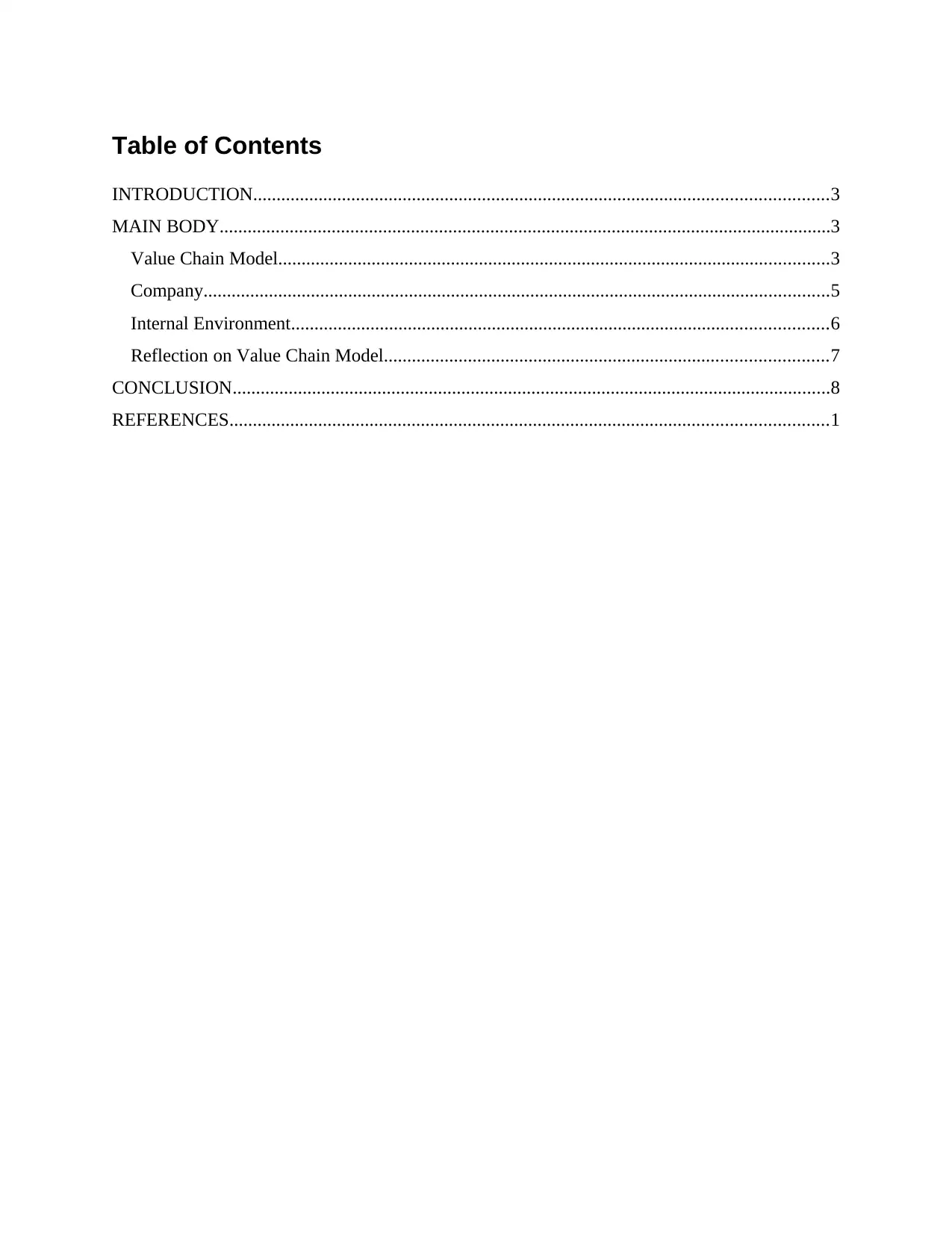
Table of Contents
INTRODUCTION...........................................................................................................................3
MAIN BODY...................................................................................................................................3
Value Chain Model......................................................................................................................3
Company......................................................................................................................................5
Internal Environment...................................................................................................................6
Reflection on Value Chain Model...............................................................................................7
CONCLUSION................................................................................................................................8
REFERENCES................................................................................................................................1
INTRODUCTION...........................................................................................................................3
MAIN BODY...................................................................................................................................3
Value Chain Model......................................................................................................................3
Company......................................................................................................................................5
Internal Environment...................................................................................................................6
Reflection on Value Chain Model...............................................................................................7
CONCLUSION................................................................................................................................8
REFERENCES................................................................................................................................1
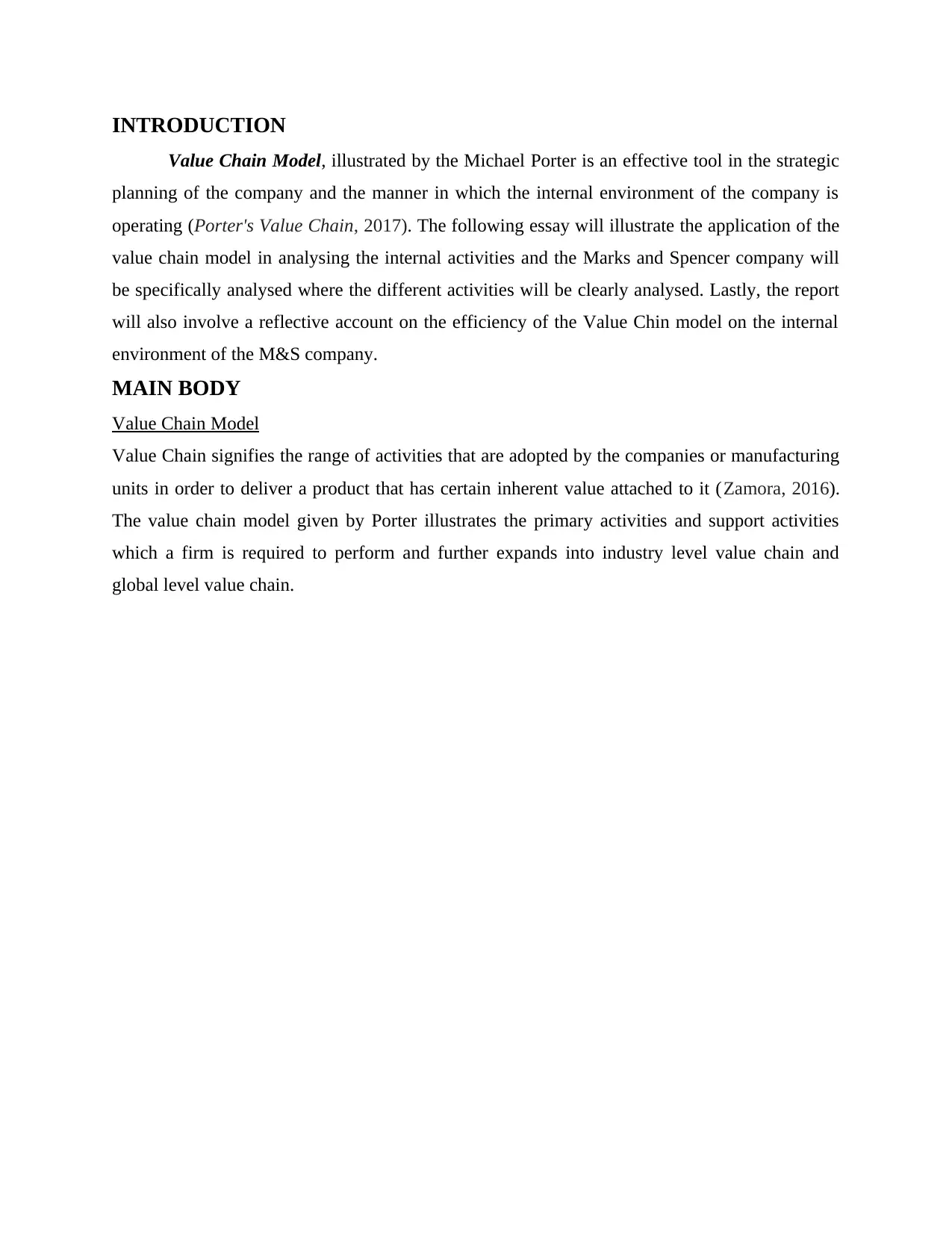
INTRODUCTION
Value Chain Model, illustrated by the Michael Porter is an effective tool in the strategic
planning of the company and the manner in which the internal environment of the company is
operating (Porter's Value Chain, 2017). The following essay will illustrate the application of the
value chain model in analysing the internal activities and the Marks and Spencer company will
be specifically analysed where the different activities will be clearly analysed. Lastly, the report
will also involve a reflective account on the efficiency of the Value Chin model on the internal
environment of the M&S company.
MAIN BODY
Value Chain Model
Value Chain signifies the range of activities that are adopted by the companies or manufacturing
units in order to deliver a product that has certain inherent value attached to it (Zamora, 2016).
The value chain model given by Porter illustrates the primary activities and support activities
which a firm is required to perform and further expands into industry level value chain and
global level value chain.
Value Chain Model, illustrated by the Michael Porter is an effective tool in the strategic
planning of the company and the manner in which the internal environment of the company is
operating (Porter's Value Chain, 2017). The following essay will illustrate the application of the
value chain model in analysing the internal activities and the Marks and Spencer company will
be specifically analysed where the different activities will be clearly analysed. Lastly, the report
will also involve a reflective account on the efficiency of the Value Chin model on the internal
environment of the M&S company.
MAIN BODY
Value Chain Model
Value Chain signifies the range of activities that are adopted by the companies or manufacturing
units in order to deliver a product that has certain inherent value attached to it (Zamora, 2016).
The value chain model given by Porter illustrates the primary activities and support activities
which a firm is required to perform and further expands into industry level value chain and
global level value chain.
⊘ This is a preview!⊘
Do you want full access?
Subscribe today to unlock all pages.

Trusted by 1+ million students worldwide
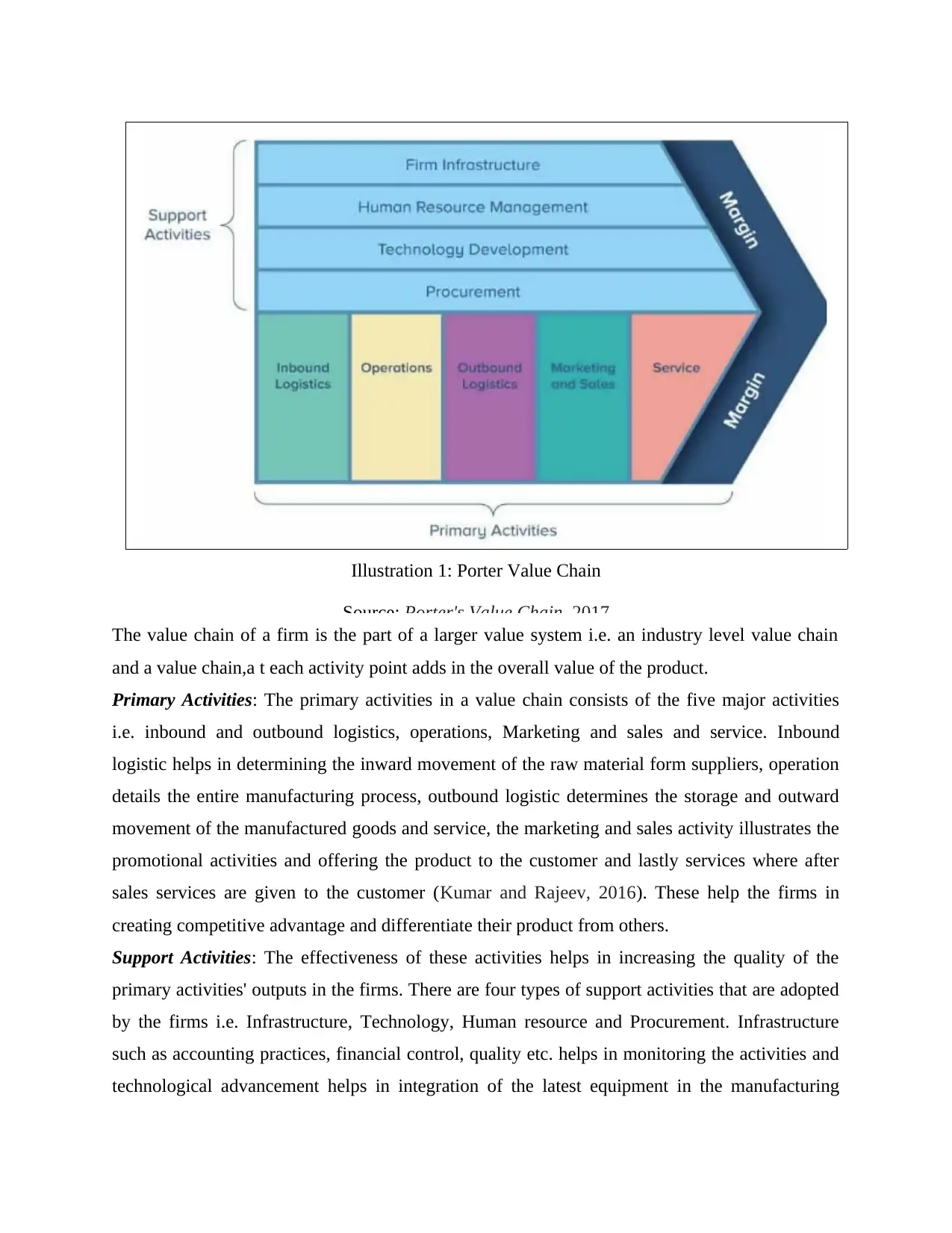
The value chain of a firm is the part of a larger value system i.e. an industry level value chain
and a value chain,a t each activity point adds in the overall value of the product.
Primary Activities: The primary activities in a value chain consists of the five major activities
i.e. inbound and outbound logistics, operations, Marketing and sales and service. Inbound
logistic helps in determining the inward movement of the raw material form suppliers, operation
details the entire manufacturing process, outbound logistic determines the storage and outward
movement of the manufactured goods and service, the marketing and sales activity illustrates the
promotional activities and offering the product to the customer and lastly services where after
sales services are given to the customer (Kumar and Rajeev, 2016). These help the firms in
creating competitive advantage and differentiate their product from others.
Support Activities: The effectiveness of these activities helps in increasing the quality of the
primary activities' outputs in the firms. There are four types of support activities that are adopted
by the firms i.e. Infrastructure, Technology, Human resource and Procurement. Infrastructure
such as accounting practices, financial control, quality etc. helps in monitoring the activities and
technological advancement helps in integration of the latest equipment in the manufacturing
Illustration 1: Porter Value Chain
Source: Porter's Value Chain, 2017
and a value chain,a t each activity point adds in the overall value of the product.
Primary Activities: The primary activities in a value chain consists of the five major activities
i.e. inbound and outbound logistics, operations, Marketing and sales and service. Inbound
logistic helps in determining the inward movement of the raw material form suppliers, operation
details the entire manufacturing process, outbound logistic determines the storage and outward
movement of the manufactured goods and service, the marketing and sales activity illustrates the
promotional activities and offering the product to the customer and lastly services where after
sales services are given to the customer (Kumar and Rajeev, 2016). These help the firms in
creating competitive advantage and differentiate their product from others.
Support Activities: The effectiveness of these activities helps in increasing the quality of the
primary activities' outputs in the firms. There are four types of support activities that are adopted
by the firms i.e. Infrastructure, Technology, Human resource and Procurement. Infrastructure
such as accounting practices, financial control, quality etc. helps in monitoring the activities and
technological advancement helps in integration of the latest equipment in the manufacturing
Illustration 1: Porter Value Chain
Source: Porter's Value Chain, 2017
Paraphrase This Document
Need a fresh take? Get an instant paraphrase of this document with our AI Paraphraser
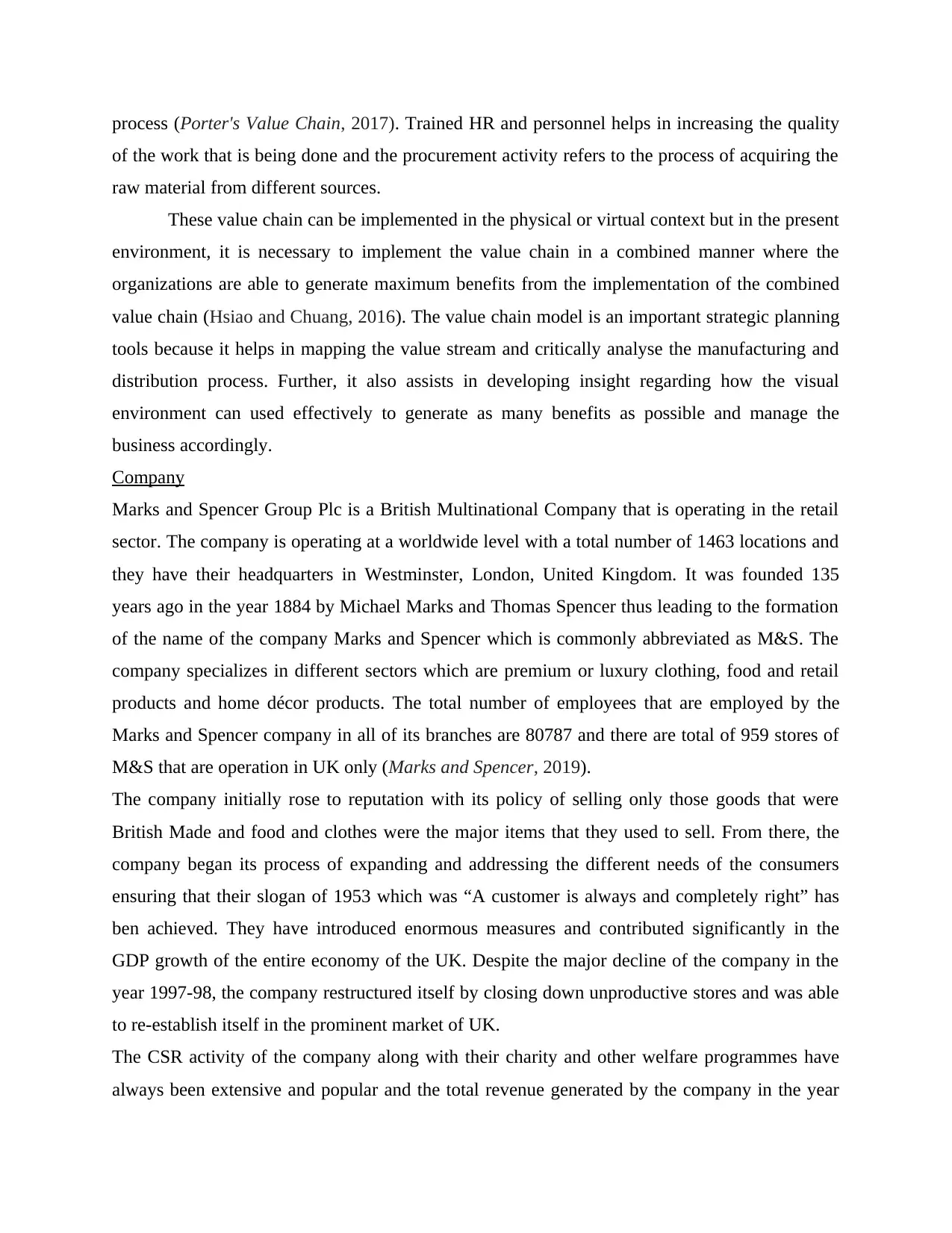
process (Porter's Value Chain, 2017). Trained HR and personnel helps in increasing the quality
of the work that is being done and the procurement activity refers to the process of acquiring the
raw material from different sources.
These value chain can be implemented in the physical or virtual context but in the present
environment, it is necessary to implement the value chain in a combined manner where the
organizations are able to generate maximum benefits from the implementation of the combined
value chain (Hsiao and Chuang, 2016). The value chain model is an important strategic planning
tools because it helps in mapping the value stream and critically analyse the manufacturing and
distribution process. Further, it also assists in developing insight regarding how the visual
environment can used effectively to generate as many benefits as possible and manage the
business accordingly.
Company
Marks and Spencer Group Plc is a British Multinational Company that is operating in the retail
sector. The company is operating at a worldwide level with a total number of 1463 locations and
they have their headquarters in Westminster, London, United Kingdom. It was founded 135
years ago in the year 1884 by Michael Marks and Thomas Spencer thus leading to the formation
of the name of the company Marks and Spencer which is commonly abbreviated as M&S. The
company specializes in different sectors which are premium or luxury clothing, food and retail
products and home décor products. The total number of employees that are employed by the
Marks and Spencer company in all of its branches are 80787 and there are total of 959 stores of
M&S that are operation in UK only (Marks and Spencer, 2019).
The company initially rose to reputation with its policy of selling only those goods that were
British Made and food and clothes were the major items that they used to sell. From there, the
company began its process of expanding and addressing the different needs of the consumers
ensuring that their slogan of 1953 which was “A customer is always and completely right” has
ben achieved. They have introduced enormous measures and contributed significantly in the
GDP growth of the entire economy of the UK. Despite the major decline of the company in the
year 1997-98, the company restructured itself by closing down unproductive stores and was able
to re-establish itself in the prominent market of UK.
The CSR activity of the company along with their charity and other welfare programmes have
always been extensive and popular and the total revenue generated by the company in the year
of the work that is being done and the procurement activity refers to the process of acquiring the
raw material from different sources.
These value chain can be implemented in the physical or virtual context but in the present
environment, it is necessary to implement the value chain in a combined manner where the
organizations are able to generate maximum benefits from the implementation of the combined
value chain (Hsiao and Chuang, 2016). The value chain model is an important strategic planning
tools because it helps in mapping the value stream and critically analyse the manufacturing and
distribution process. Further, it also assists in developing insight regarding how the visual
environment can used effectively to generate as many benefits as possible and manage the
business accordingly.
Company
Marks and Spencer Group Plc is a British Multinational Company that is operating in the retail
sector. The company is operating at a worldwide level with a total number of 1463 locations and
they have their headquarters in Westminster, London, United Kingdom. It was founded 135
years ago in the year 1884 by Michael Marks and Thomas Spencer thus leading to the formation
of the name of the company Marks and Spencer which is commonly abbreviated as M&S. The
company specializes in different sectors which are premium or luxury clothing, food and retail
products and home décor products. The total number of employees that are employed by the
Marks and Spencer company in all of its branches are 80787 and there are total of 959 stores of
M&S that are operation in UK only (Marks and Spencer, 2019).
The company initially rose to reputation with its policy of selling only those goods that were
British Made and food and clothes were the major items that they used to sell. From there, the
company began its process of expanding and addressing the different needs of the consumers
ensuring that their slogan of 1953 which was “A customer is always and completely right” has
ben achieved. They have introduced enormous measures and contributed significantly in the
GDP growth of the entire economy of the UK. Despite the major decline of the company in the
year 1997-98, the company restructured itself by closing down unproductive stores and was able
to re-establish itself in the prominent market of UK.
The CSR activity of the company along with their charity and other welfare programmes have
always been extensive and popular and the total revenue generated by the company in the year
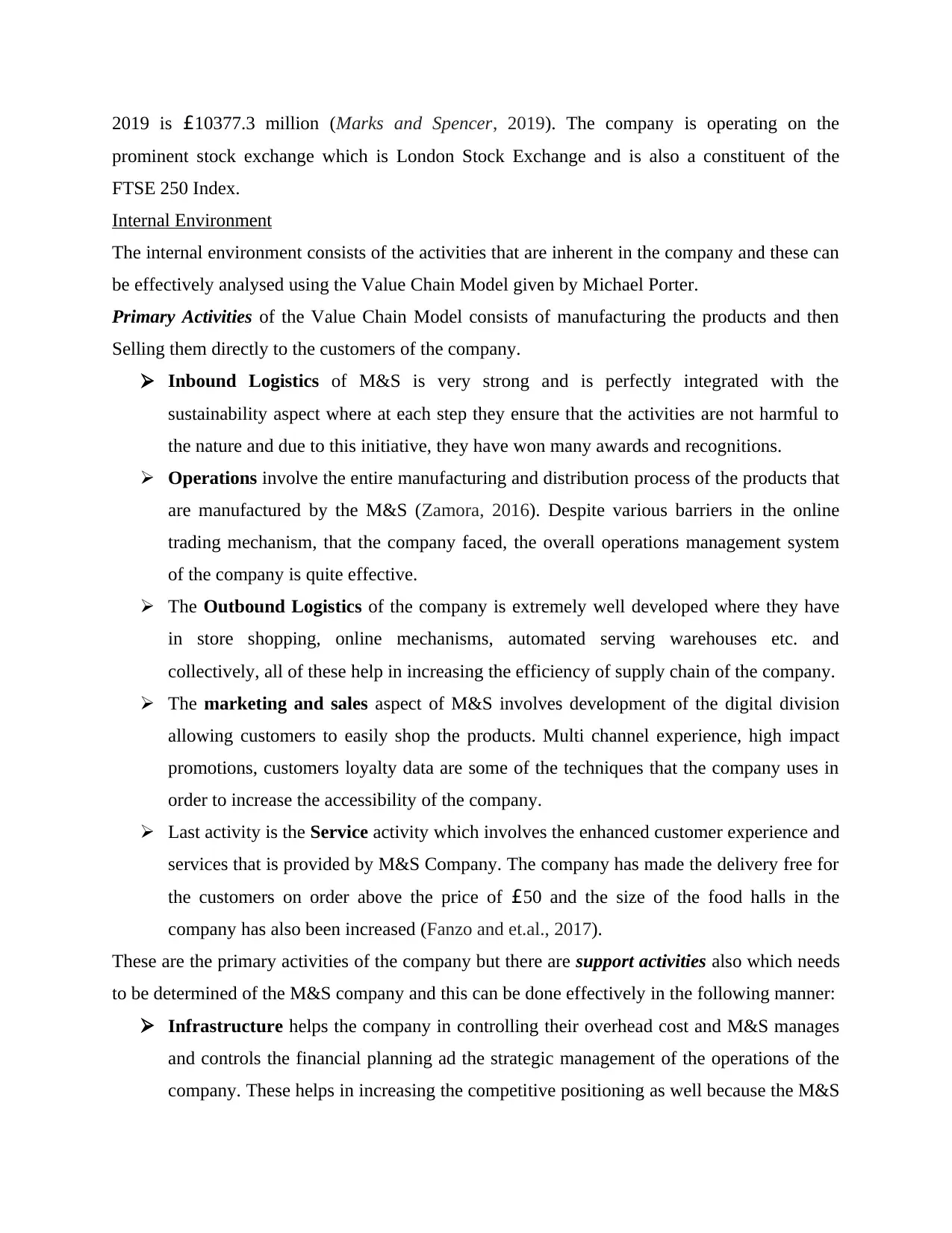
2019 is £10377.3 million (Marks and Spencer, 2019). The company is operating on the
prominent stock exchange which is London Stock Exchange and is also a constituent of the
FTSE 250 Index.
Internal Environment
The internal environment consists of the activities that are inherent in the company and these can
be effectively analysed using the Value Chain Model given by Michael Porter.
Primary Activities of the Value Chain Model consists of manufacturing the products and then
Selling them directly to the customers of the company.
Inbound Logistics of M&S is very strong and is perfectly integrated with the
sustainability aspect where at each step they ensure that the activities are not harmful to
the nature and due to this initiative, they have won many awards and recognitions.
Operations involve the entire manufacturing and distribution process of the products that
are manufactured by the M&S (Zamora, 2016). Despite various barriers in the online
trading mechanism, that the company faced, the overall operations management system
of the company is quite effective.
The Outbound Logistics of the company is extremely well developed where they have
in store shopping, online mechanisms, automated serving warehouses etc. and
collectively, all of these help in increasing the efficiency of supply chain of the company.
The marketing and sales aspect of M&S involves development of the digital division
allowing customers to easily shop the products. Multi channel experience, high impact
promotions, customers loyalty data are some of the techniques that the company uses in
order to increase the accessibility of the company.
Last activity is the Service activity which involves the enhanced customer experience and
services that is provided by M&S Company. The company has made the delivery free for
the customers on order above the price of £50 and the size of the food halls in the
company has also been increased (Fanzo and et.al., 2017).
These are the primary activities of the company but there are support activities also which needs
to be determined of the M&S company and this can be done effectively in the following manner:
Infrastructure helps the company in controlling their overhead cost and M&S manages
and controls the financial planning ad the strategic management of the operations of the
company. These helps in increasing the competitive positioning as well because the M&S
prominent stock exchange which is London Stock Exchange and is also a constituent of the
FTSE 250 Index.
Internal Environment
The internal environment consists of the activities that are inherent in the company and these can
be effectively analysed using the Value Chain Model given by Michael Porter.
Primary Activities of the Value Chain Model consists of manufacturing the products and then
Selling them directly to the customers of the company.
Inbound Logistics of M&S is very strong and is perfectly integrated with the
sustainability aspect where at each step they ensure that the activities are not harmful to
the nature and due to this initiative, they have won many awards and recognitions.
Operations involve the entire manufacturing and distribution process of the products that
are manufactured by the M&S (Zamora, 2016). Despite various barriers in the online
trading mechanism, that the company faced, the overall operations management system
of the company is quite effective.
The Outbound Logistics of the company is extremely well developed where they have
in store shopping, online mechanisms, automated serving warehouses etc. and
collectively, all of these help in increasing the efficiency of supply chain of the company.
The marketing and sales aspect of M&S involves development of the digital division
allowing customers to easily shop the products. Multi channel experience, high impact
promotions, customers loyalty data are some of the techniques that the company uses in
order to increase the accessibility of the company.
Last activity is the Service activity which involves the enhanced customer experience and
services that is provided by M&S Company. The company has made the delivery free for
the customers on order above the price of £50 and the size of the food halls in the
company has also been increased (Fanzo and et.al., 2017).
These are the primary activities of the company but there are support activities also which needs
to be determined of the M&S company and this can be done effectively in the following manner:
Infrastructure helps the company in controlling their overhead cost and M&S manages
and controls the financial planning ad the strategic management of the operations of the
company. These helps in increasing the competitive positioning as well because the M&S
⊘ This is a preview!⊘
Do you want full access?
Subscribe today to unlock all pages.

Trusted by 1+ million students worldwide
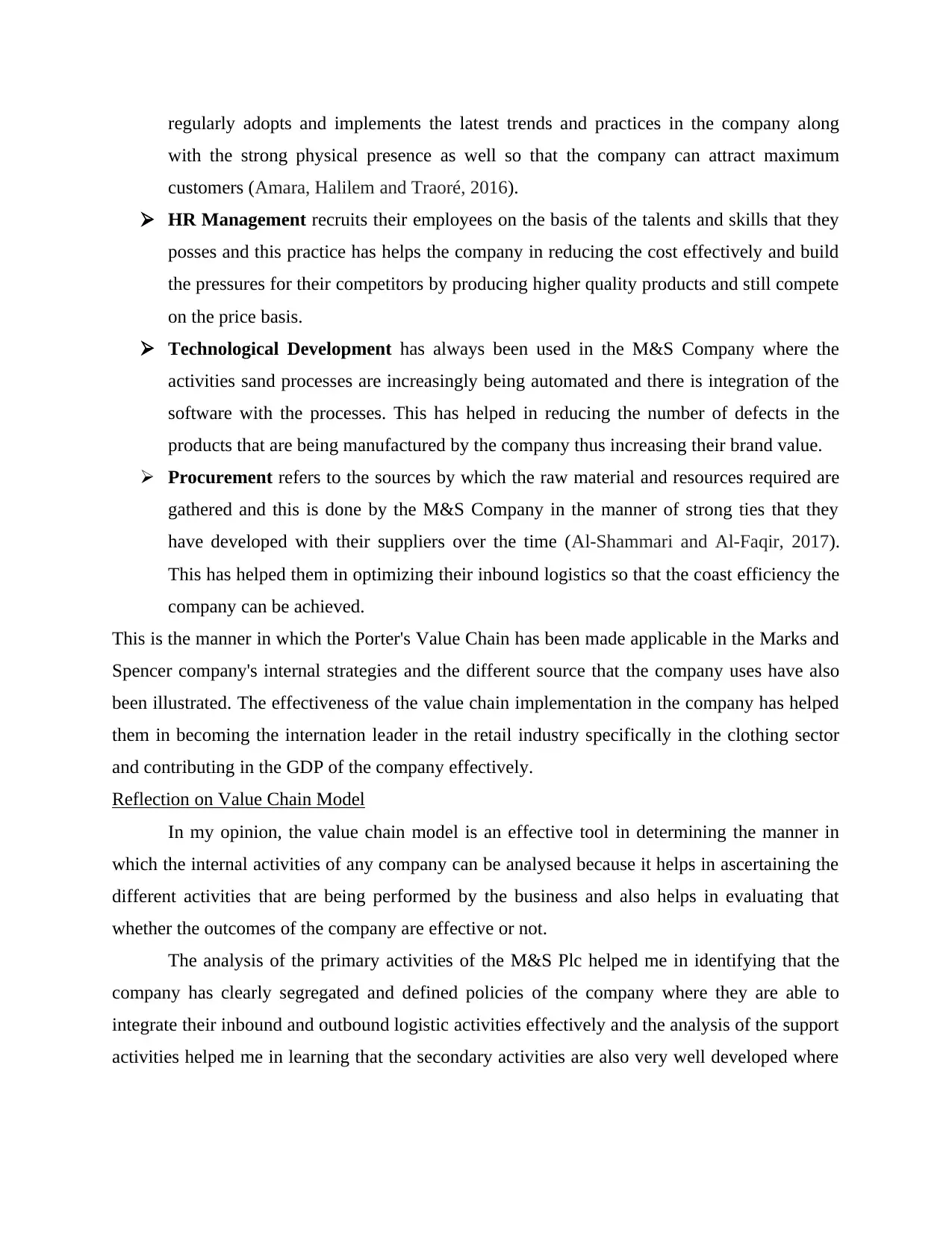
regularly adopts and implements the latest trends and practices in the company along
with the strong physical presence as well so that the company can attract maximum
customers (Amara, Halilem and Traoré, 2016).
HR Management recruits their employees on the basis of the talents and skills that they
posses and this practice has helps the company in reducing the cost effectively and build
the pressures for their competitors by producing higher quality products and still compete
on the price basis.
Technological Development has always been used in the M&S Company where the
activities sand processes are increasingly being automated and there is integration of the
software with the processes. This has helped in reducing the number of defects in the
products that are being manufactured by the company thus increasing their brand value.
Procurement refers to the sources by which the raw material and resources required are
gathered and this is done by the M&S Company in the manner of strong ties that they
have developed with their suppliers over the time (Al-Shammari and Al-Faqir, 2017).
This has helped them in optimizing their inbound logistics so that the coast efficiency the
company can be achieved.
This is the manner in which the Porter's Value Chain has been made applicable in the Marks and
Spencer company's internal strategies and the different source that the company uses have also
been illustrated. The effectiveness of the value chain implementation in the company has helped
them in becoming the internation leader in the retail industry specifically in the clothing sector
and contributing in the GDP of the company effectively.
Reflection on Value Chain Model
In my opinion, the value chain model is an effective tool in determining the manner in
which the internal activities of any company can be analysed because it helps in ascertaining the
different activities that are being performed by the business and also helps in evaluating that
whether the outcomes of the company are effective or not.
The analysis of the primary activities of the M&S Plc helped me in identifying that the
company has clearly segregated and defined policies of the company where they are able to
integrate their inbound and outbound logistic activities effectively and the analysis of the support
activities helped me in learning that the secondary activities are also very well developed where
with the strong physical presence as well so that the company can attract maximum
customers (Amara, Halilem and Traoré, 2016).
HR Management recruits their employees on the basis of the talents and skills that they
posses and this practice has helps the company in reducing the cost effectively and build
the pressures for their competitors by producing higher quality products and still compete
on the price basis.
Technological Development has always been used in the M&S Company where the
activities sand processes are increasingly being automated and there is integration of the
software with the processes. This has helped in reducing the number of defects in the
products that are being manufactured by the company thus increasing their brand value.
Procurement refers to the sources by which the raw material and resources required are
gathered and this is done by the M&S Company in the manner of strong ties that they
have developed with their suppliers over the time (Al-Shammari and Al-Faqir, 2017).
This has helped them in optimizing their inbound logistics so that the coast efficiency the
company can be achieved.
This is the manner in which the Porter's Value Chain has been made applicable in the Marks and
Spencer company's internal strategies and the different source that the company uses have also
been illustrated. The effectiveness of the value chain implementation in the company has helped
them in becoming the internation leader in the retail industry specifically in the clothing sector
and contributing in the GDP of the company effectively.
Reflection on Value Chain Model
In my opinion, the value chain model is an effective tool in determining the manner in
which the internal activities of any company can be analysed because it helps in ascertaining the
different activities that are being performed by the business and also helps in evaluating that
whether the outcomes of the company are effective or not.
The analysis of the primary activities of the M&S Plc helped me in identifying that the
company has clearly segregated and defined policies of the company where they are able to
integrate their inbound and outbound logistic activities effectively and the analysis of the support
activities helped me in learning that the secondary activities are also very well developed where
Paraphrase This Document
Need a fresh take? Get an instant paraphrase of this document with our AI Paraphraser
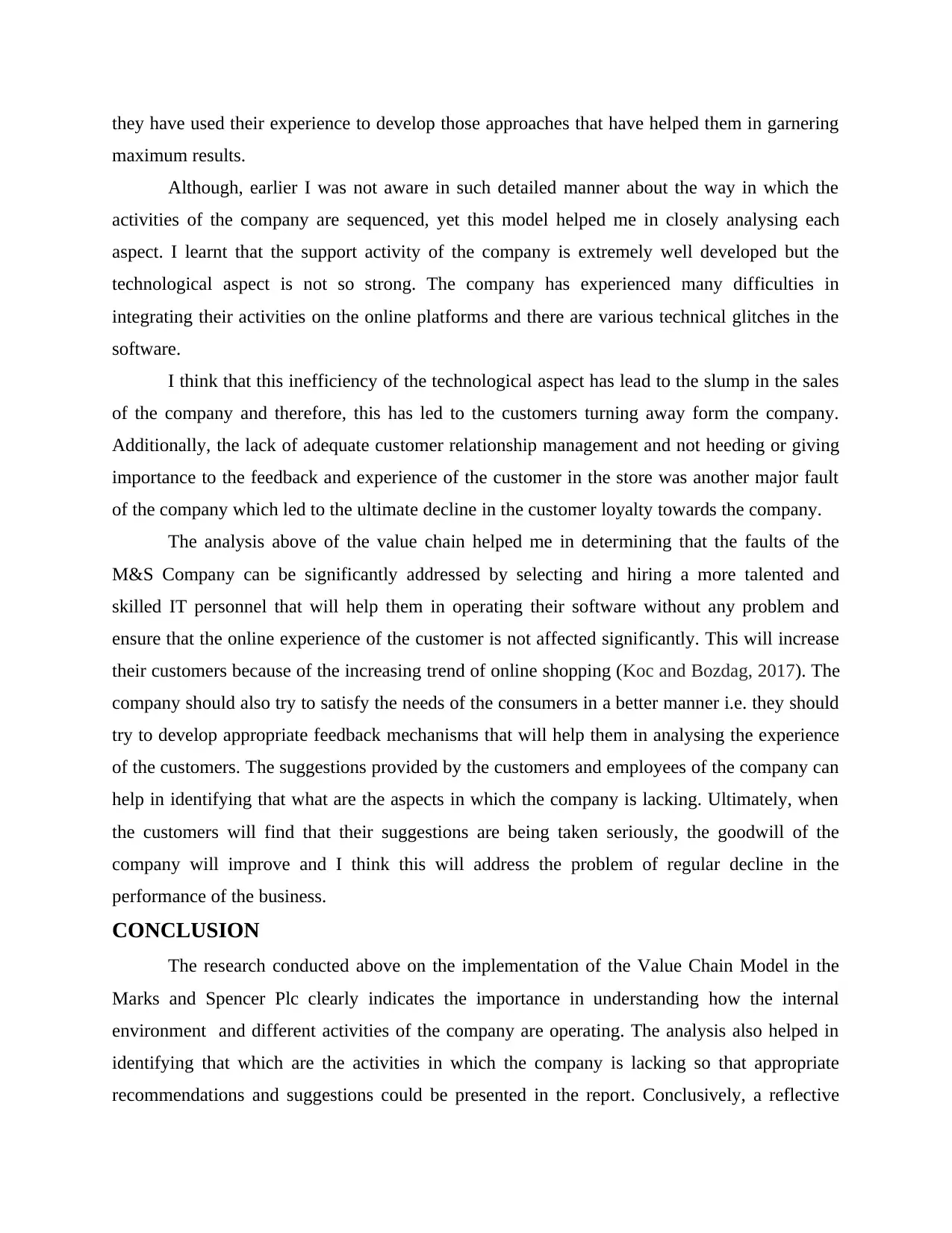
they have used their experience to develop those approaches that have helped them in garnering
maximum results.
Although, earlier I was not aware in such detailed manner about the way in which the
activities of the company are sequenced, yet this model helped me in closely analysing each
aspect. I learnt that the support activity of the company is extremely well developed but the
technological aspect is not so strong. The company has experienced many difficulties in
integrating their activities on the online platforms and there are various technical glitches in the
software.
I think that this inefficiency of the technological aspect has lead to the slump in the sales
of the company and therefore, this has led to the customers turning away form the company.
Additionally, the lack of adequate customer relationship management and not heeding or giving
importance to the feedback and experience of the customer in the store was another major fault
of the company which led to the ultimate decline in the customer loyalty towards the company.
The analysis above of the value chain helped me in determining that the faults of the
M&S Company can be significantly addressed by selecting and hiring a more talented and
skilled IT personnel that will help them in operating their software without any problem and
ensure that the online experience of the customer is not affected significantly. This will increase
their customers because of the increasing trend of online shopping (Koc and Bozdag, 2017). The
company should also try to satisfy the needs of the consumers in a better manner i.e. they should
try to develop appropriate feedback mechanisms that will help them in analysing the experience
of the customers. The suggestions provided by the customers and employees of the company can
help in identifying that what are the aspects in which the company is lacking. Ultimately, when
the customers will find that their suggestions are being taken seriously, the goodwill of the
company will improve and I think this will address the problem of regular decline in the
performance of the business.
CONCLUSION
The research conducted above on the implementation of the Value Chain Model in the
Marks and Spencer Plc clearly indicates the importance in understanding how the internal
environment and different activities of the company are operating. The analysis also helped in
identifying that which are the activities in which the company is lacking so that appropriate
recommendations and suggestions could be presented in the report. Conclusively, a reflective
maximum results.
Although, earlier I was not aware in such detailed manner about the way in which the
activities of the company are sequenced, yet this model helped me in closely analysing each
aspect. I learnt that the support activity of the company is extremely well developed but the
technological aspect is not so strong. The company has experienced many difficulties in
integrating their activities on the online platforms and there are various technical glitches in the
software.
I think that this inefficiency of the technological aspect has lead to the slump in the sales
of the company and therefore, this has led to the customers turning away form the company.
Additionally, the lack of adequate customer relationship management and not heeding or giving
importance to the feedback and experience of the customer in the store was another major fault
of the company which led to the ultimate decline in the customer loyalty towards the company.
The analysis above of the value chain helped me in determining that the faults of the
M&S Company can be significantly addressed by selecting and hiring a more talented and
skilled IT personnel that will help them in operating their software without any problem and
ensure that the online experience of the customer is not affected significantly. This will increase
their customers because of the increasing trend of online shopping (Koc and Bozdag, 2017). The
company should also try to satisfy the needs of the consumers in a better manner i.e. they should
try to develop appropriate feedback mechanisms that will help them in analysing the experience
of the customers. The suggestions provided by the customers and employees of the company can
help in identifying that what are the aspects in which the company is lacking. Ultimately, when
the customers will find that their suggestions are being taken seriously, the goodwill of the
company will improve and I think this will address the problem of regular decline in the
performance of the business.
CONCLUSION
The research conducted above on the implementation of the Value Chain Model in the
Marks and Spencer Plc clearly indicates the importance in understanding how the internal
environment and different activities of the company are operating. The analysis also helped in
identifying that which are the activities in which the company is lacking so that appropriate
recommendations and suggestions could be presented in the report. Conclusively, a reflective

account was also detailed in the report and this helped in ascertaining the views of the writer of
the report that whether the value chain model is an effective tool or not for analysing the internal
environment of the company and then subsequently, the writer's suggestions were included in the
report.
the report that whether the value chain model is an effective tool or not for analysing the internal
environment of the company and then subsequently, the writer's suggestions were included in the
report.
⊘ This is a preview!⊘
Do you want full access?
Subscribe today to unlock all pages.

Trusted by 1+ million students worldwide
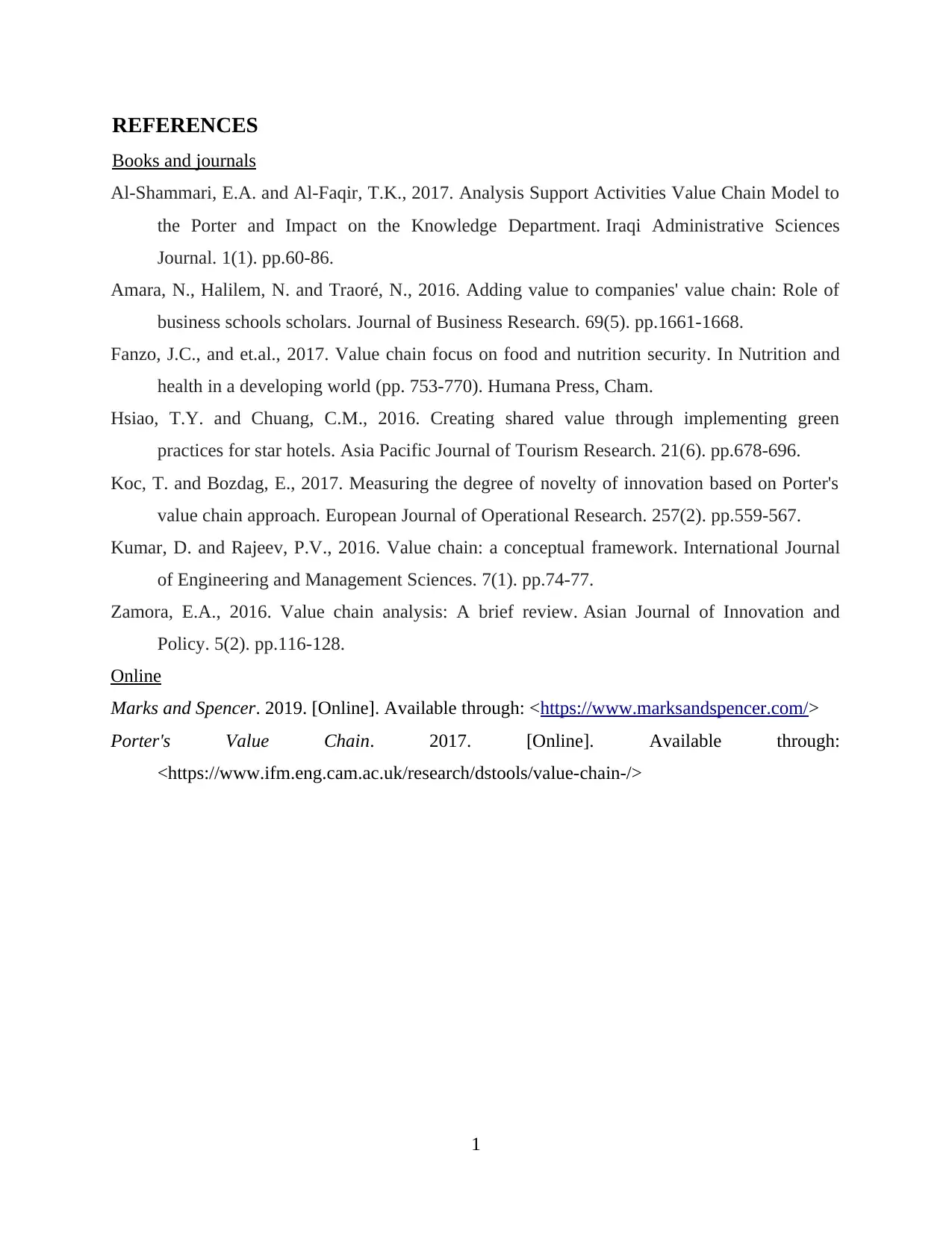
REFERENCES
Books and journals
Al-Shammari, E.A. and Al-Faqir, T.K., 2017. Analysis Support Activities Value Chain Model to
the Porter and Impact on the Knowledge Department. Iraqi Administrative Sciences
Journal. 1(1). pp.60-86.
Amara, N., Halilem, N. and Traoré, N., 2016. Adding value to companies' value chain: Role of
business schools scholars. Journal of Business Research. 69(5). pp.1661-1668.
Fanzo, J.C., and et.al., 2017. Value chain focus on food and nutrition security. In Nutrition and
health in a developing world (pp. 753-770). Humana Press, Cham.
Hsiao, T.Y. and Chuang, C.M., 2016. Creating shared value through implementing green
practices for star hotels. Asia Pacific Journal of Tourism Research. 21(6). pp.678-696.
Koc, T. and Bozdag, E., 2017. Measuring the degree of novelty of innovation based on Porter's
value chain approach. European Journal of Operational Research. 257(2). pp.559-567.
Kumar, D. and Rajeev, P.V., 2016. Value chain: a conceptual framework. International Journal
of Engineering and Management Sciences. 7(1). pp.74-77.
Zamora, E.A., 2016. Value chain analysis: A brief review. Asian Journal of Innovation and
Policy. 5(2). pp.116-128.
Online
Marks and Spencer. 2019. [Online]. Available through: <https://www.marksandspencer.com/>
Porter's Value Chain. 2017. [Online]. Available through:
<https://www.ifm.eng.cam.ac.uk/research/dstools/value-chain-/>
1
Books and journals
Al-Shammari, E.A. and Al-Faqir, T.K., 2017. Analysis Support Activities Value Chain Model to
the Porter and Impact on the Knowledge Department. Iraqi Administrative Sciences
Journal. 1(1). pp.60-86.
Amara, N., Halilem, N. and Traoré, N., 2016. Adding value to companies' value chain: Role of
business schools scholars. Journal of Business Research. 69(5). pp.1661-1668.
Fanzo, J.C., and et.al., 2017. Value chain focus on food and nutrition security. In Nutrition and
health in a developing world (pp. 753-770). Humana Press, Cham.
Hsiao, T.Y. and Chuang, C.M., 2016. Creating shared value through implementing green
practices for star hotels. Asia Pacific Journal of Tourism Research. 21(6). pp.678-696.
Koc, T. and Bozdag, E., 2017. Measuring the degree of novelty of innovation based on Porter's
value chain approach. European Journal of Operational Research. 257(2). pp.559-567.
Kumar, D. and Rajeev, P.V., 2016. Value chain: a conceptual framework. International Journal
of Engineering and Management Sciences. 7(1). pp.74-77.
Zamora, E.A., 2016. Value chain analysis: A brief review. Asian Journal of Innovation and
Policy. 5(2). pp.116-128.
Online
Marks and Spencer. 2019. [Online]. Available through: <https://www.marksandspencer.com/>
Porter's Value Chain. 2017. [Online]. Available through:
<https://www.ifm.eng.cam.ac.uk/research/dstools/value-chain-/>
1
Paraphrase This Document
Need a fresh take? Get an instant paraphrase of this document with our AI Paraphraser

2
1 out of 11
Related Documents
Your All-in-One AI-Powered Toolkit for Academic Success.
+13062052269
info@desklib.com
Available 24*7 on WhatsApp / Email
![[object Object]](/_next/static/media/star-bottom.7253800d.svg)
Unlock your academic potential
Copyright © 2020–2025 A2Z Services. All Rights Reserved. Developed and managed by ZUCOL.





